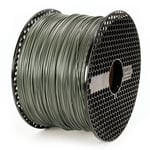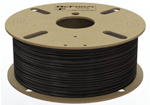When your hobby is melting plastic for hours on end, you might have wondered what kind of impact you’re having on the environment. While additive manufacturing is a less wasteful production method than subtractive manufacturing, when done as a hobby, the products of 3D printing can be, largely, waste.
Some filament manufacturers flag ‘recyclable’ in their marketing, but this is oftentimes not the case, especially when considering that many local recycling facilities won’t accept unmarked scrap 3D prints, leaving you to hunt for specialty recycling services. So, flipping this problem on its head, instead of looking to recycle plastic prints you’ve made, you can seek out filaments that come from recycled plastic. Print using the solution.
Suppose you aren’t particular about using virgin plastic, which is another term for freshly synthesized plastic that has never been used before. In that case, there are plenty of ways to leverage 3D printing materials as a solution for existing waste just by choosing filaments made by environmentally positive manufacturers.
In this article, we’ll list some of the manufacturers we know to be acting and producing filaments in an environmentally conscious manner along with some non-traditional filament materials that also fit the earth-friendly spirit. Let’s get started!
Fillamentum NonOilen

NonOilen, Fillamentum‘s bioplastic offering, is a novel blend of industrially compostable PLA and bioplastic polyhydroxybutyrate (PHB). This PLA/PHB filament is a widely used filament that’s trusted by many hobbyists and professional 3D printers, notably automotive parts supplier Fremach, which uses it to produce fully recyclable prototype parts.
Fillamentum emphasizes that this filament is approved for food contact, so it can be used to make kitchen gadgets and can even handle liquids, though it’s a good idea to make sure that your 3D printer is producing watertight 3D prints before trying this.
NonOilen is available in its natural color, likely to avoid introducing chemical dyes into the biodegradable waste stream. It’s important to note that, because of its PLA content, this filament cannot be composted outside of industrial facilities, so don’t dispose of it in the environment.
- Color: Natural
- Sizes: 1.75, 2.85 mm (0.75-kg spool)
- Recommended settings: Hotend 175-195 °C, heated bed 0-50 °C
- Price per kg: ~$44 ($58 for 0.75-kg spool)
3D Printlife Algix Alga
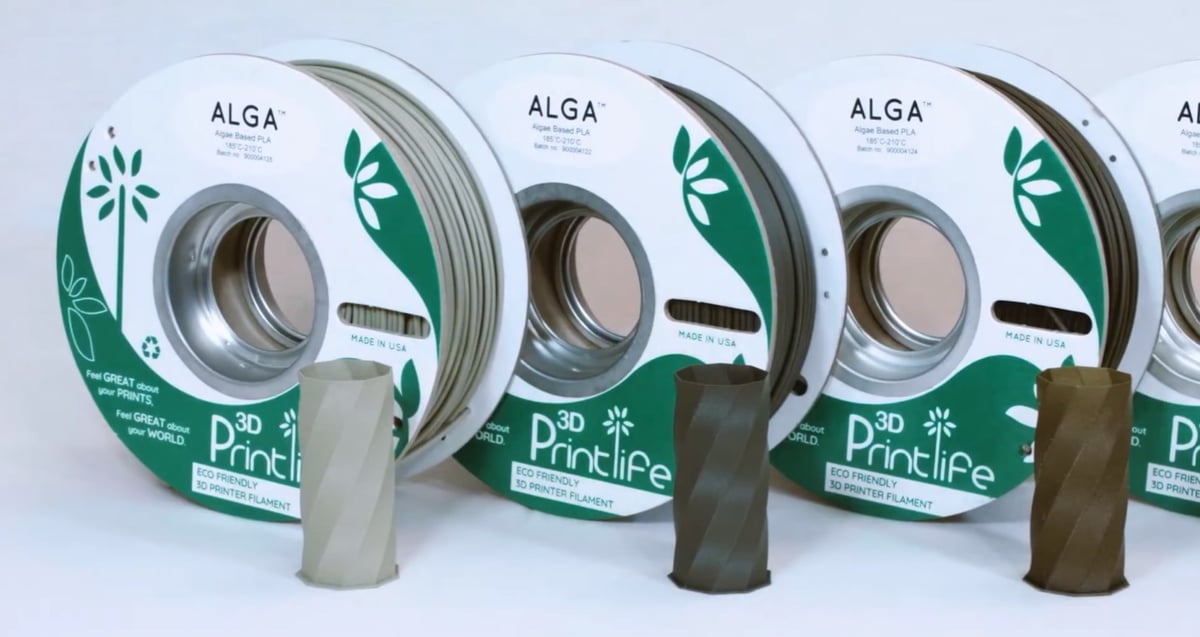
A cornerstone of responsible environmental practices is taking something destructive to the environment and turning it into something good, or at least using it to replace something worse in the supply chain. Though plenty of plastic recycling is taking place in the filament industry, there’s nothing quite like 3D Printlife’s Algix Alga, a thermoplastic filament derived from algae.
Algae is thriving in the present CO2-rich conditions of Earth, and it’s poisoning the planet’s water. Removing algae can alleviate this problem somewhat but, without a use for the material, scaling its collection is difficult.
3D Printlife’s Alga filament is one application for the toxic mush, and buying it directly helps to remove “nuisance algae”, as 3D Printlife describes it, from the environment. As a blend with virgin PLA, the filament prints with standard settings, with some mild temperature and speed quirks.
Honestly, it’s not so unusual to use algae in manufactured plastic. Bloom, an Algix company, uses nuisance algae to make responsible footwear in collaboration with major brands, so the use case is well established. That said, as a 3D printing material, Alga has had somewhat of a troubled life with mixed reviews as to its usefulness (and smell).
- Colors: Gray, red
- Sizes: 1.75, 2.85 mm (1 kg-spool)
- Recommended settings: Hotend 185-210 °C, heated bed up to 70 °C
- Price per kg: ~$35
Beyond Plastic PHA

Beyond Plastic PHA takes sustainability to an entirely new level by sourcing its raw materials from renewable resources. Its particular filament blend of polyhydroxyalkanoates (PHA) comes from biomass fermentation and is biodegradable in typical outdoor conditions (unlike PLA, which requires industrial composting techniques). In fact, Beyond Plastic reports its PHA as conforming to the ASTM 6991 Standard of Marine Biodegradability, which means that more than 70% of this plastic degrades into biogases in a laboratory test meant to simulate a marine chemical and biological environment. (This does not mean you should be throwing PHA waste into the ocean, though!)
Beyond Plastic PHA comes in both rigid and flexible variants, and can print at a similar temperature to PLA without a heated bed. Lower heating needs mean less energy usage – another win. This sustainability comes at a small cost, though, as the price of PHA is about double that of PLA. Additionally, the composition of the feedstock leads to small inconsistencies in coloration across the spool, as well as tolerance variations up to 0.1 mm.
Despite this relatively loose tolerance, a Reddit community of PHA filament users has already managed to create some high-quality 3D prints with this material using printers like the Bambu Lab X1 Carbon. At the time of writing, Beyond Plastic delivers only to the United States.
- Colors: 7 options, including yellow, green, and natural
- Sizes: 1.75 mm (0.6, 1-kg spool)
- Recommended settings: Hotend 190-200 °C, heated bed off
- Price per kg: ~$30
Treed Pneumatique Thermoplastic Elastomer
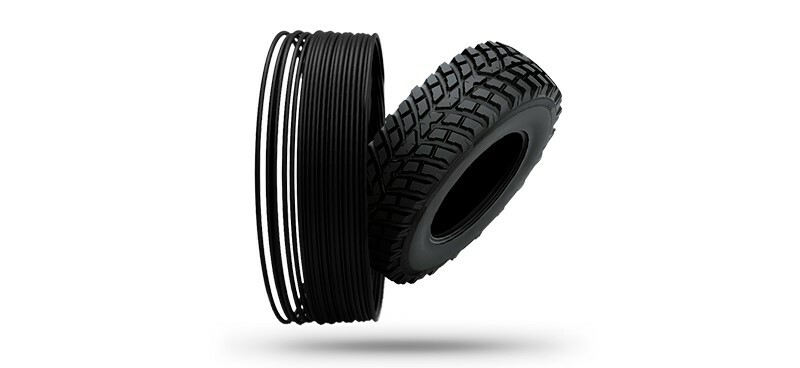
One variety of filament that’s sorely lacking environmentally friendly options is flexibles. We don’t see much in the way of recycled TPU filament or many other rubbery substitutes, but one that has caught our attention recently is Treed’s Pneumatique Thermoplastic Elastomer made from waste tires.
Tires are a massive headache in regard to responsible disposal. There are a lot of them, and they leech nasty chemicals into the ground when disposed of improperly (such as in landfills). There have been plenty of applications found for used tires, but not enough to keep up with their massive production. Well, now there’s one more avenue in flexible 3D printer filament.
Treed claims that one tire can provide enough material for nine 500-gram spools of filament. Since there’s more supply of waste tires than the world seems able to handle, the material sounds scalable, and that would actually save the planet quite some trouble.
Unfortunately, we couldn’t find detailed technical specifications about this material, but some members of the community have produced great results with it that are reportedly quite durable. Just make sure to purge the extruder with a cleaning filament after using Treed Pneumatique, as its high rubber content might cause clogs if left unchecked.
- Color: Black
- Sizes: 1.75, 2.85 mm (0.5 kg-spool)
- Recommended settings: Hotend 215 °C, heated bed 30 °C
- Price per kg: ~$93
Fishy Filaments Nylon
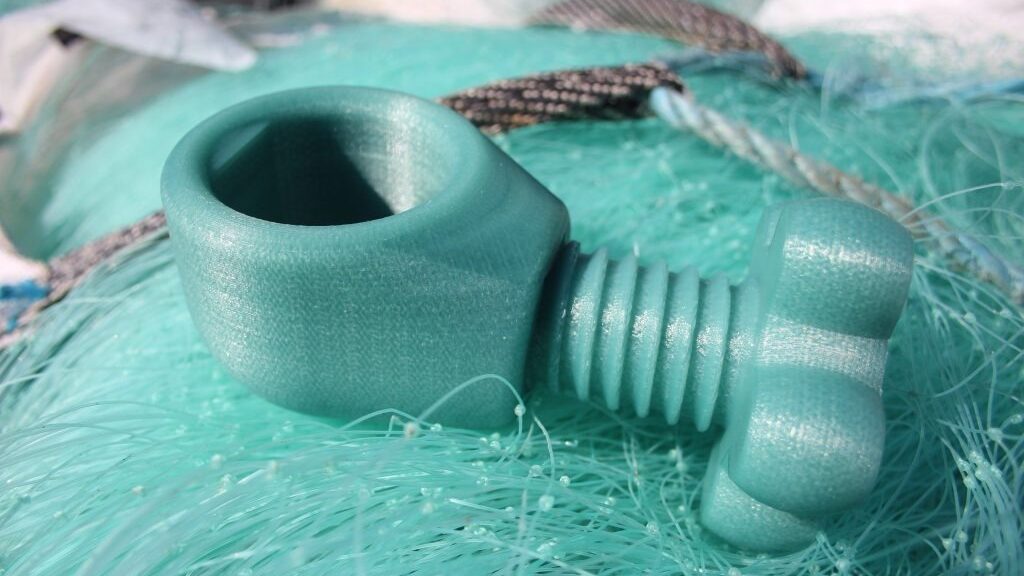
Fishing nets are another difficult waste material that troubles the world. There’s an abundance of waste nets, too degraded for their intended use, made of synthetic PA6 plastic. Fishy Filaments, now part of Fillamentum, has observed this material abundance in its home of Cornish, UK, and reprocessed the waste nets into what looks to be a high-quality Nylon filament.
Nylon, or PA6, is an important manufacturing material. It’s exceptionally high-strength, making it highly sought after by manufacturers with the most demanding applications. Fortunately, Fishy Filaments’ “Porthcurno” blend seems to hold up to virgin PA6. The material has a comparable tensile strength to the high-quality virgin PA6, according to technical specifications, and even boasts a higher flexural modulus.
The manufacturer says it stays away from additives as much as possible to preserve the material’s integrity, so you also get a unique fishing net blue-green color from its blends. If you’re looking for a sustainable filament for mechanically demanding applications, a carbon fiber/fishing-net nylon filament called OrCA is also available with 10% carbon fiber, with potentially even more heavy-duty options on their way.
- Color: Fishing net green
- Sizes: 1.75 mm (0.75-kg spool)
- Recommended settings: Hotend 250-280 °C, heated bed 80-110 °C
- Price per kg: ~$77 ($55 for 0.75-kg spool)
Fiberlogy R Series

Manufacturers outside the 3D printing industry use PLA and other thermoplastics for production. Inevitably, these processes result in waste material that can be difficult to sell or dispose of responsibly. Some filament manufacturers make use of these clean waste streams by recycling the material into filament, one example being Fiberlogy’s R Series.
Fiberlogy offers its R Series filament in three varieties: rPLA, rPETG, rABS, rPP, and rPA12. All R Series filaments are produced from recycled materials, but the supply streams aren’t as transparent as some manufacturers.
You may already know Fiberlogy for its refill offerings: the company sells “master spools” and offers refills that are wound and secured with simple zip ties at a discount, further reducing material consumption. The most environmentally friendly material is one that doesn’t exist, after all, and eliminating spools goes a long way.
Purchasing recycled materials from companies like Fiberlogy that source non-virgin feedstock helps to grow the recycling market and gives a new life to materials that would otherwise be wasted. Note that rPA12, the recycled nylon option, differs from the other options in that it only comes in 0.75-kg spools for ~$40 per roll (at the time of writing, it’s out of stock).
- Color: Black (all materials)
- Sizes: 1.75 mm (0.85 kg-spool)
- Recommended settings: Hotend 210-230 °C, heated bed 50-70 °C for rPLA
- Price per kg: $22-$26 ($19-22 for 0.85-kg spool)
PolyTerra PLA Edition R

In terms of a mostly-virgin filament with environmentally conscious practices surrounding it, Polymaker’s PolyTerra PLA stands out. The company describes PolyTerra as its “first step… towards creating more eco-sustainable products”. It uses a combination of virgin Ingeo PLA and 30% industrial waste PLA to produce its Edition R PLA, which comes on a recycled (and recyclable) cardboard spool.
Polymaker’s other contribution also takes the form of transparency – it commissioned a study into PolyTerra’s compostability. Some information is accessible via Polymaker’s website, but All3DP received the full report on request.
PLA is a biodegradable material, a fact often touted in filament marketing materials, but only in industrial composting environments. Since it’s not clear whether most municipal bio-waste programs will accept even marked PLA waste, that is a bit of a non-starter. Polymaker’s report does little to help now, but with more transparency like it, users and municipalities can review the details and consider options for the future.
- Color: Black
- Sizes: 1.75, 2.85 mm (1 kg-spool)
- Recommended settings: Hotend 190-230 °C, heated bed 25-60 °C
- Price per kg: ~$24
Prusament PLA Recycled

Some companies are so particular about waste-supply streams that they’ll only use their own. Internal closed-loop filament manufacturing helps ensure tight quality control and eliminates manufacturing waste. While it’s a good practice to encourage, it just doesn’t always scale.
Prusa Research is one such company recycling its waste material from filament manufacturing and using more environmentally-conscious practices throughout its facility. Prusa’s filament line, Prusament, has been popular since it hit the market. It now uses the waste material from its factory, plus select local customers, for some interesting environmentally conscious practices, such as injection molding some plastic printer parts.
All its filament spool sides are from recycled polycarbonate (PC) materials, too (although demand outstrips Prusa’s ability to supply waste, so external sources of waste PC are used to keep up). Though Prusa said in January 2021 that producing recycled filament is “not an option”, it released a recycled filament for consumer purchase in December of the same year, so something seems to have changed.
This new recycled PLA isn’t using the same standards as Prusa’s other manufacturing processes, though. The material is only sourced internally, and only from PLA spools that don’t meet Prusa’s tight ±0.02 mm diameter tolerance for its standard filament. The recycled PLA has a larger deviation, ±0.05 mm, and only comes in 2-kg spools. The color is a bit of a dice roll, too. Since Prusa doesn’t use any additives in the recycling process, the material’s color is determined by whatever waste filament is used. That same principle also means Prusa’s “PLA Recycled” is only available in limited runs.
- Color: Silvery, but can vary from batch to batch
- Sizes: 1.75 mm (2-kg spool)
- Recommended settings: Hotend 215 °C, heated bed 50-60 °C
- Price per kg: ~$25 ($45 for 2-kg spool)
FormFutura ReForm
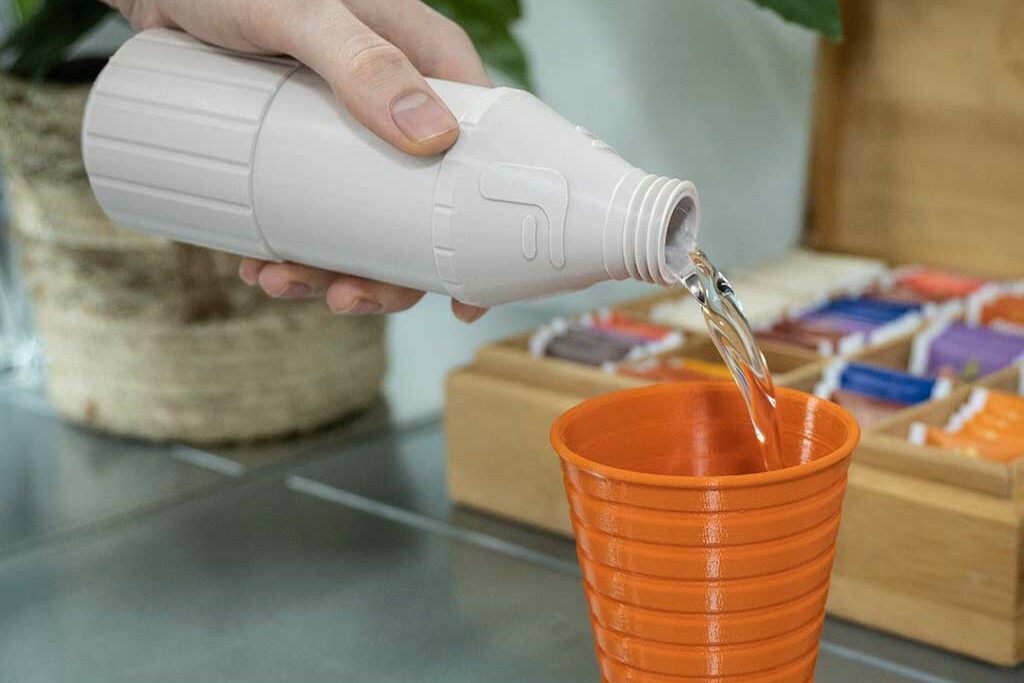
If you need a variety of recycled materials from a reliable manufacturer with a high degree of traceability, FormFutura fits the bill.
Two products in FormFutura’s well-known ReForm line are made from 100% waste filament from FormFutura’s own virgin material production. The material sources are entirely traceable because they’re completely internal. The company specifies which virgin filament line each ReForm material is derived from on the respective product pages. ReForm filaments are available as rPLA (recycled EasyFil PLA), rPET (recycled HDglass PETG), rApollo (recycled ApolloX ASA), and rTitan (recycled TitanX ABS).
FormFutura notes that the coloring of the filaments may have some variation due to the mixed material origin, however, white and black options are likely to be true to color as this waste is separately collected. Unlike other recycled filament options, these filaments come in a wide range of spool sizes, which makes it a great budget choice for large prototyping parts and other functional prints.
- Colors: 8 for rPLA, 13 for rPET, 3 for rApollo, 3 for rTitan
- Sizes: 1.75, 2.85 mm (various spool sizes from 0.25 kg to 4.5 kg)
- Recommended settings: Hotend 200-215°C, heated bed 50-60°C for rPLA
- Price per kg: $20-33
Reflow Filaments
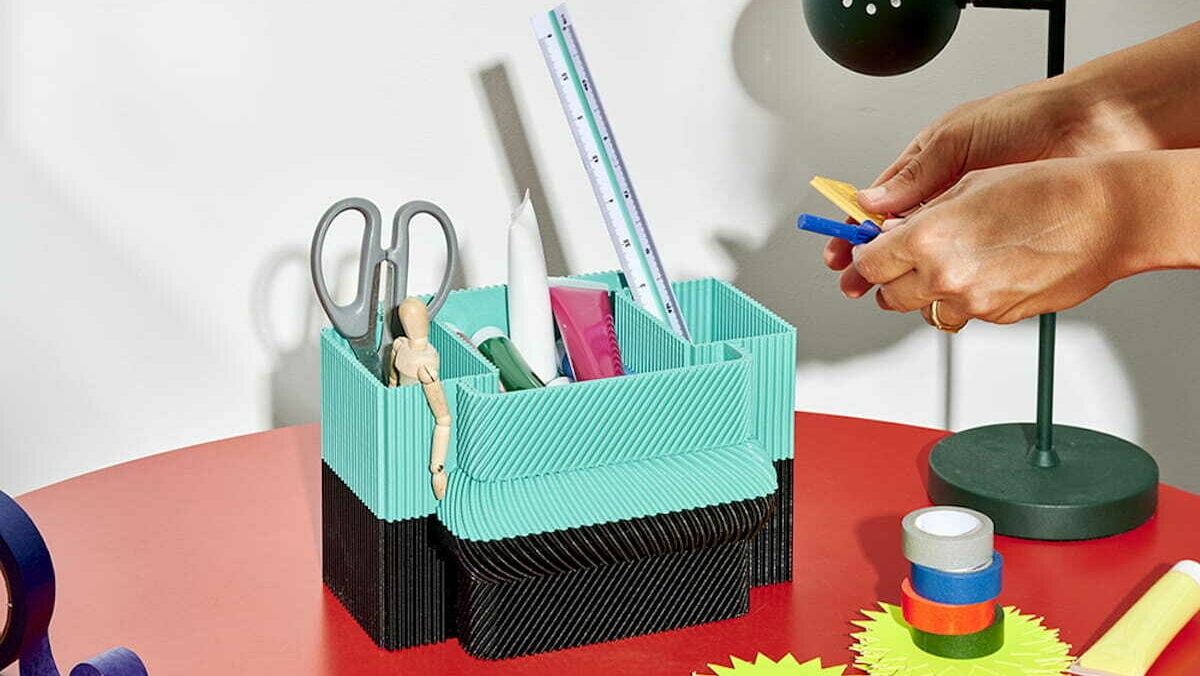
Reflow is another manufacturer externally sourcing its material feedstock, but its focus is on traceable sourcing. The Netherlands-based manufacturer has developed recycled filaments from the most common materials – rPETG and rPLA, and provides an easily accessible material overview on its website with the sourcing information for each material sold.
rPLA is sourced from industrial packaging waste and rPETG is derived exclusively from medical tray production waste in North Holland. Reflow calls this waste stream “incredibly clean”, which should help material integrity.
Reflow’s two high-strength composite filament options, rPP x GF and rPA x CF, are sourced from fishing nets and dismantled wind turbines, respectively. While the polymer parts of these filaments are definitely recycled, it is less clear whether or not the glass fibers or carbon fibers come from recycled sources.
- Colors: 30 PLA options, including opaque, translucent, and matte variations, plus 26 PETG options in translucent and opaque versions
- Sizes: 1.75, 2.85 mm (various spool sizes from 0.8 kg to 4 kg)
- Recommended settings: Hotend 215-225 °C, heated bed 40-70 °C for Essential PLA
- Price per kg: $25-30
Redline Filament Industrial Recycled PETG
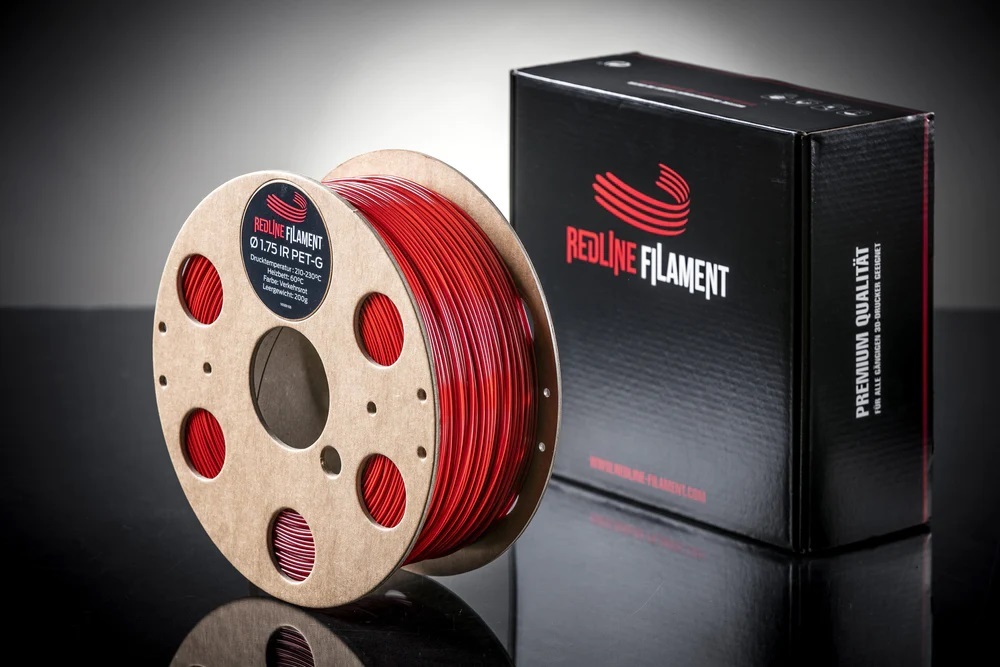
Another filament manufacturer sourcing industrial waste materials is the Germany-based Redline Filament. It sources waste PETG from the injection molding industry and upcycles it into “Industrial Recycled” IR-PETG. Redline will then crush, dry, dye, and reprocess the manufacturing waste material into filament suitable for 3D printing. The company points out that, while its feedstock isn’t virgin PETG, it also hasn’t been exposed to any potential contaminants, helping ensure high quality even from recycled material.
By disclosing its material sourcing, Redline makes it clear its supply stream provides clean material for quality filament. But, by focusing on PETG, one of the most popular materials in and outside of 3D printing, Redline doesn’t pigeonhole itself to too specific a supply chain, ensuring they have room to add or pivot suppliers and keep up with demand.
Redline ships this externally-sourced PETG internationally, but shipping outside Europe will cost ~$50. If you happen to be around Dormagen, just South of Düsseldorf, Germany, you can collect your order for free and help curb emissions, too.
- Colors: 8 options, including the signature traffic red
- Sizes: 1.75 mm (1-kg spool)
- Recommended settings: Hotend 240°C, heated bed 70°C
- Price per kg: ~$30
License: The text of "The Best Sustainable 3D Printer Filaments in 2024" by All3DP is licensed under a Creative Commons Attribution 4.0 International License.
CERTAIN CONTENT THAT APPEARS ON THIS SITE COMES FROM AMAZON. THIS CONTENT IS PROVIDED ‘AS IS’ AND IS SUBJECT TO CHANGE OR REMOVAL AT ANY TIME.






